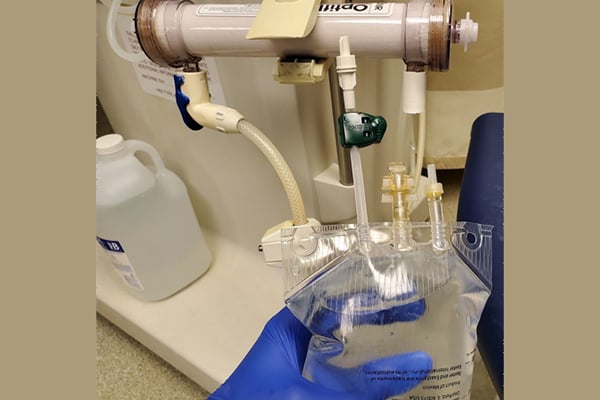The ongoing COVID-19 pandemic has severely impacted the manufacturing and supply chains for many products. But while shortages of toilet paper, disinfectant cleaners, and hand sanitizer get most of the news coverage, the diminishing reserve of one item — kidney dialysis fluid, also known as dialysate — presents a grave threat to the lives of people with acute kidney injury (AKI), including the approximately 3% to 9% of COVID-19 patients who develop the disorder.
Without the special type of 24-hour, slowly administered dialysis — called continuous veno-venous hemodialysis, or CVVHD — that is given to AKI patients in an intensive care unit, damaged kidneys cannot remove wastes and excess fluids from the blood as they normally do. Unfortunately, the COVID-19 pandemic has severely tapped dialysate supplies across the nation.
When two New York-based hospitals recently contacted Derek Fine, clinical director of nephrology at the Johns Hopkins University School of Medicine, to seek spare dialysate to help meet their need for some 3,000 liters per day (for all of their AKI patients in ICUs, both with and without COVID-19), he and Chirag Parikh, director of the medical school’s Division of Nephrology, came up with a better idea to remedy the problem.
Their solution was to replace the dwindling stocks of pre-mixed, commercially produced dialysate required for short-term ICU kidney dialysis machines with a suitable substitute manufactured by conventional hemodialysis devices and designed for long-term treatment.
The latter creates its own dialysate in real time from ultrapure water and concentrated chemical solutions.
Fine, Parikh, and colleagues from their division studied the workings of a conventional dialysis machine, learned how it manufactures dialysate and then adjusted the system to override alarms, which if triggered would automatically shut down dialysate production. However, one major obstacle remained: how to get the newly minted dialysate into bags.
No problem, thanks to students from the Johns Hopkins Whiting School of Engineering. Ryan Bell and Brielle Cenci, master’s students in the Center for Bioengineering Innovation and Design within the Department of Biomedical Engineering, and Mohit Singhala from the Department of Mechanical Engineering, were able to design a connector and use a 3-D printer to render the plastic piece within just 12 hours.
“When we tried it out, we were successfully able to capture the dialysate, and that was the eureka moment,” Parikh says.
The U.S. Food and Drug Administration has already provided guidelines for the method, calling for all dialysate produced to be tested intermittently for bacteria and used within 12 hours from its origin. The two New York hospitals that spurred the birth of the new technique are reporting that it has enabled them to maintain sufficient supplies of dialysate for CVVHD.

